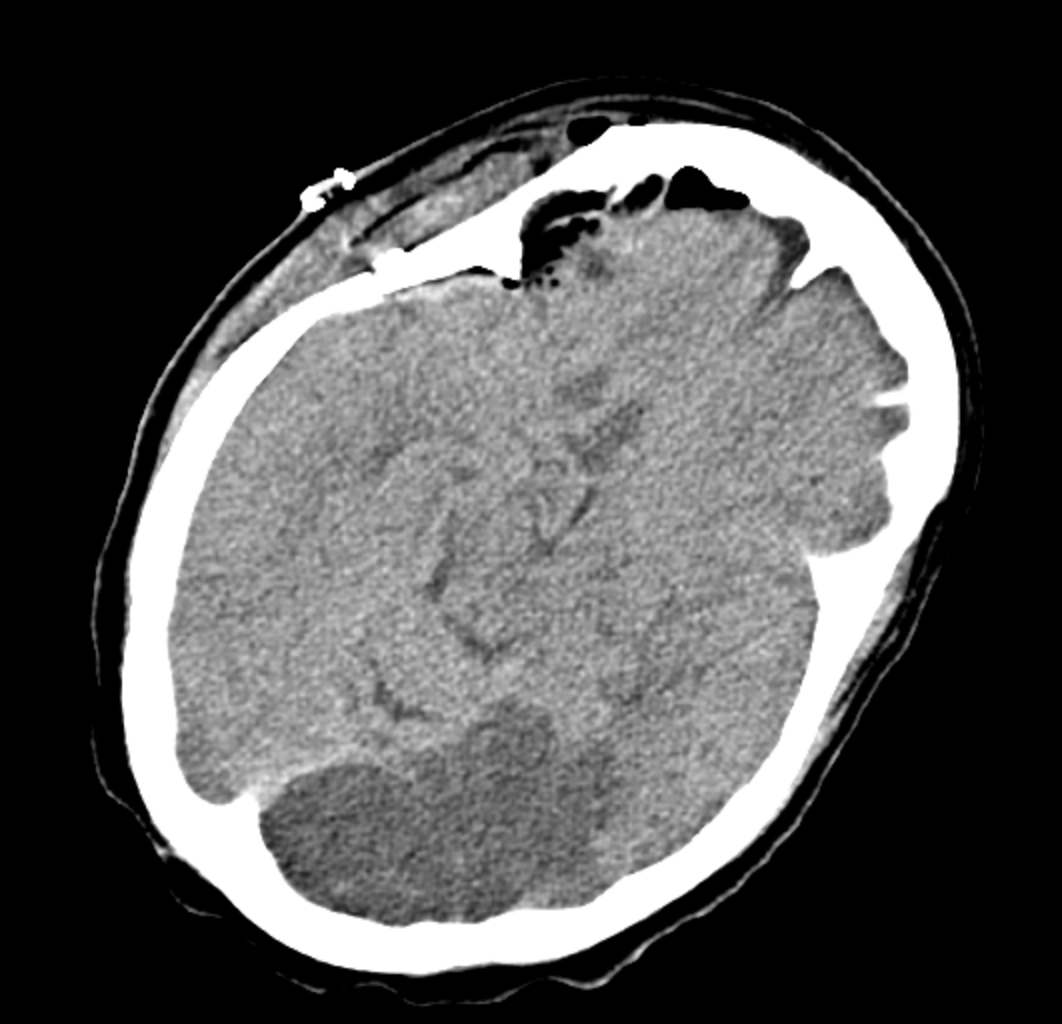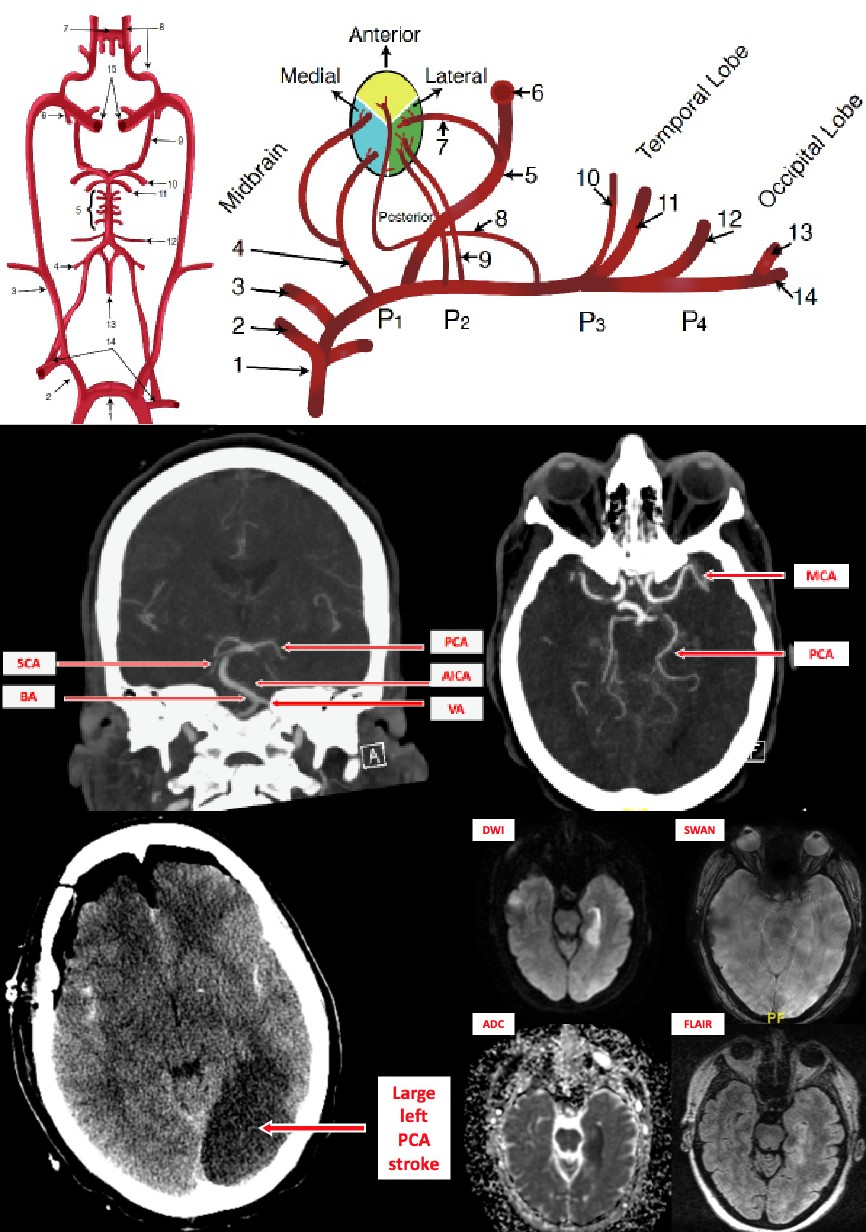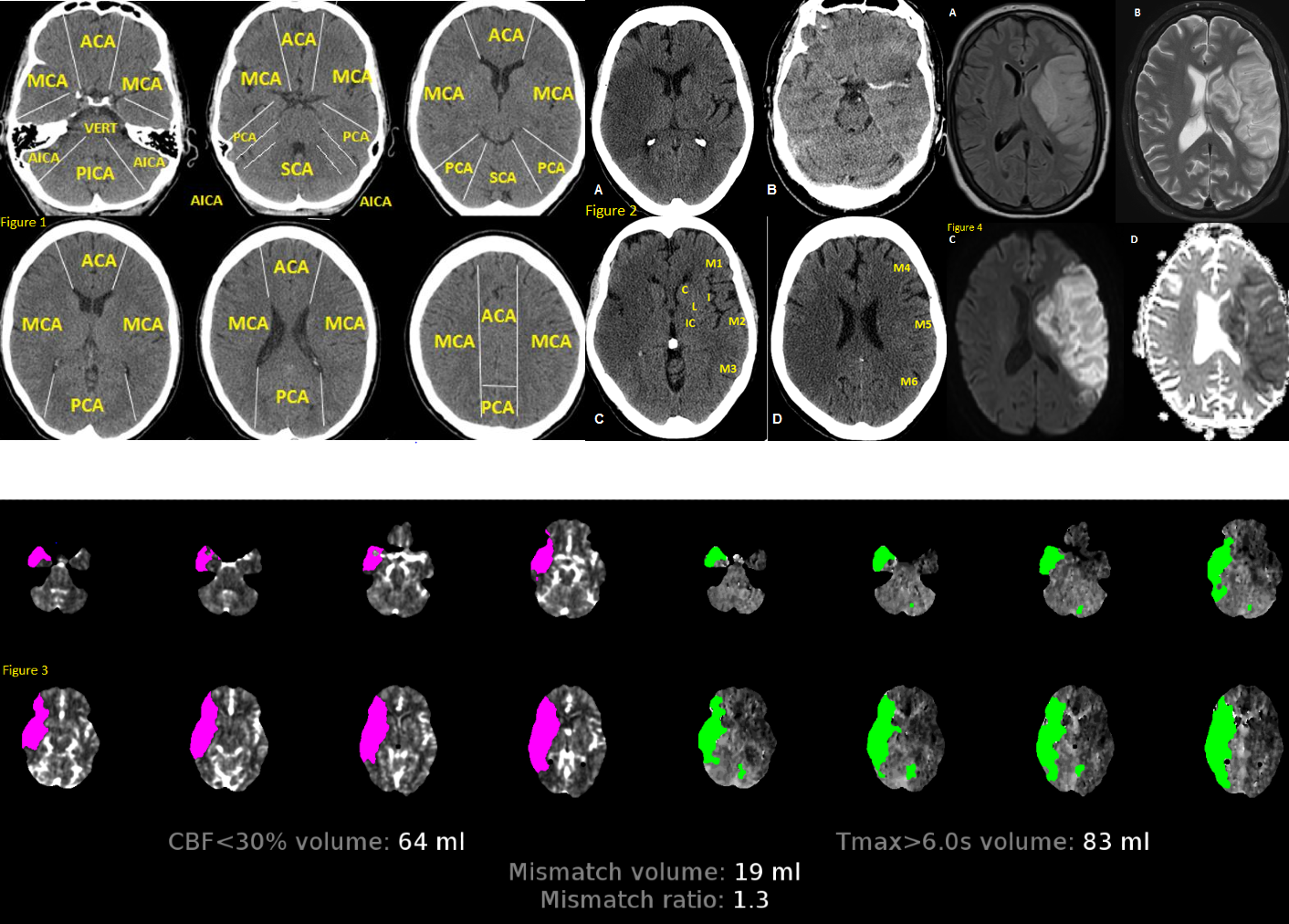[1]
Cereda C, Carrera E. Posterior cerebral artery territory infarctions. Frontiers of neurology and neuroscience. 2012:30():128-31. doi: 10.1159/000333610. Epub 2012 Feb 14
[PubMed PMID: 22377879]
[2]
Percheron G, The anatomy of the arterial supply of the human thalamus and its use for the interpretation of the thalamic vascular pathology. Zeitschrift fur Neurologie. 1973 Aug 29
[PubMed PMID: 4126735]
[3]
Lazzaro NA,Wright B,Castillo M,Fischbein NJ,Glastonbury CM,Hildenbrand PG,Wiggins RH,Quigley EP,Osborn AG, Artery of percheron infarction: imaging patterns and clinical spectrum. AJNR. American journal of neuroradiology. 2010 Aug
[PubMed PMID: 20299438]
[4]
Yamamoto Y, Georgiadis AL, Chang HM, Caplan LR. Posterior cerebral artery territory infarcts in the New England Medical Center Posterior Circulation Registry. Archives of neurology. 1999 Jul:56(7):824-32
[PubMed PMID: 10404984]
[5]
Arboix A, Arbe G, García-Eroles L, Oliveres M, Parra O, Massons J. Infarctions in the vascular territory of the posterior cerebral artery: clinical features in 232 patients. BMC research notes. 2011 Sep 7:4():329. doi: 10.1186/1756-0500-4-329. Epub 2011 Sep 7
[PubMed PMID: 21899750]
[6]
Ntaios G, Spengos K, Vemmou AM, Savvari P, Koroboki E, Stranjalis G, Vemmos K. Long-term outcome in posterior cerebral artery stroke. European journal of neurology. 2011 Aug:18(8):1074-80. doi: 10.1111/j.1468-1331.2011.03384.x. Epub 2011 Mar 24
[PubMed PMID: 21435108]
[7]
Caplan LR, Estol CJ, Massaro AR. Dissection of the posterior cerebral arteries. Archives of neurology. 2005 Jul:62(7):1138-43
[PubMed PMID: 16009773]
[8]
Cals N, Devuyst G, Afsar N, Karapanayiotides T, Bogousslavsky J. Pure superficial posterior cerebral artery territory infarction in The Lausanne Stroke Registry. Journal of neurology. 2002 Jul:249(7):855-61
[PubMed PMID: 12140669]
[9]
Tashiro K, Shigeto H, Tanaka M, Kawajiri M, Taniwaki T, Kira J. [Fibromuscular dysplasia of the basilar artery presenting as cerebral infarction in a young female]. Rinsho shinkeigaku = Clinical neurology. 2006 Jan:46(1):35-9
[PubMed PMID: 16541792]
[10]
Majamaa K, Turkka J, Kärppä M, Winqvist S, Hassinen IE. The common MELAS mutation A3243G in mitochondrial DNA among young patients with an occipital brain infarct. Neurology. 1997 Nov:49(5):1331-4
[PubMed PMID: 9371917]
[11]
Passero S, Filosomi G. Posterior circulation infarcts in patients with vertebrobasilar dolichoectasia. Stroke. 1998 Mar:29(3):653-9
[PubMed PMID: 9506608]
[12]
Yang Q, Tong X, Schieb L, Vaughan A, Gillespie C, Wiltz JL, King SC, Odom E, Merritt R, Hong Y, George MG. Vital Signs: Recent Trends in Stroke Death Rates - United States, 2000-2015. MMWR. Morbidity and mortality weekly report. 2017 Sep 8:66(35):933-939. doi: 10.15585/mmwr.mm6635e1. Epub 2017 Sep 8
[PubMed PMID: 28880858]
[13]
Benjamin EJ, Blaha MJ, Chiuve SE, Cushman M, Das SR, Deo R, de Ferranti SD, Floyd J, Fornage M, Gillespie C, Isasi CR, Jiménez MC, Jordan LC, Judd SE, Lackland D, Lichtman JH, Lisabeth L, Liu S, Longenecker CT, Mackey RH, Matsushita K, Mozaffarian D, Mussolino ME, Nasir K, Neumar RW, Palaniappan L, Pandey DK, Thiagarajan RR, Reeves MJ, Ritchey M, Rodriguez CJ, Roth GA, Rosamond WD, Sasson C, Towfighi A, Tsao CW, Turner MB, Virani SS, Voeks JH, Willey JZ, Wilkins JT, Wu JH, Alger HM, Wong SS, Muntner P, American Heart Association Statistics Committee and Stroke Statistics Subcommittee. Heart Disease and Stroke Statistics-2017 Update: A Report From the American Heart Association. Circulation. 2017 Mar 7:135(10):e146-e603. doi: 10.1161/CIR.0000000000000485. Epub 2017 Jan 25
[PubMed PMID: 28122885]
[16]
Neau JP, Bogousslavsky J. The syndrome of posterior choroidal artery territory infarction. Annals of neurology. 1996 Jun:39(6):779-88
[PubMed PMID: 8651650]
[17]
Kondziella D, Frahm-Falkenberg S. Anton's syndrome and eugenics. Journal of clinical neurology (Seoul, Korea). 2011 Jun:7(2):96-8. doi: 10.3988/jcn.2011.7.2.96. Epub 2011 Jun 28
[PubMed PMID: 21779298]
[18]
Larrabee GJ, Levin HS, Huff FJ, Kay MC, Guinto FC Jr. Visual agnosia contrasted with visual-verbal disconnection. Neuropsychologia. 1985:23(1):1-12
[PubMed PMID: 3974844]
[19]
Gainotti G, Marra C. Differential contribution of right and left temporo-occipital and anterior temporal lesions to face recognition disorders. Frontiers in human neuroscience. 2011:5():55. doi: 10.3389/fnhum.2011.00055. Epub 2011 Jun 1
[PubMed PMID: 21687793]
[20]
Landis T, Cummings JL, Christen L, Bogen JE, Imhof HG. Are unilateral right posterior cerebral lesions sufficient to cause prosopagnosia? Clinical and radiological findings in six additional patients. Cortex; a journal devoted to the study of the nervous system and behavior. 1986 Jun:22(2):243-52
[PubMed PMID: 3731794]
[21]
Damasio A, Yamada T, Damasio H, Corbett J, McKee J. Central achromatopsia: behavioral, anatomic, and physiologic aspects. Neurology. 1980 Oct:30(10):1064-71
[PubMed PMID: 6968419]
[22]
Botez SA, Carrera E, Maeder P, Bogousslavsky J. Aggressive behavior and posterior cerebral artery stroke. Archives of neurology. 2007 Jul:64(7):1029-33
[PubMed PMID: 17620495]
[23]
HECAEN H, DE AJURIAGUERRA J. Balint's syndrome (psychic paralysis of visual fixation) and its minor forms. Brain : a journal of neurology. 1954:77(3):373-400
[PubMed PMID: 13208876]
[26]
Fisher CM. The posterior cerebral artery syndrome. The Canadian journal of neurological sciences. Le journal canadien des sciences neurologiques. 1986 Aug:13(3):232-9
[PubMed PMID: 3742339]
[27]
Sato S, Toyoda K, Uehara T, Toratani N, Yokota C, Moriwaki H, Naritomi H, Minematsu K. Baseline NIH Stroke Scale Score predicting outcome in anterior and posterior circulation strokes. Neurology. 2008 Jun 10:70(24 Pt 2):2371-7. doi: 10.1212/01.wnl.0000304346.14354.0b. Epub 2008 Apr 23
[PubMed PMID: 18434640]
[28]
Puetz V, Sylaja PN, Coutts SB, Hill MD, Dzialowski I, Mueller P, Becker U, Urban G, O'Reilly C, Barber PA, Sharma P, Goyal M, Gahn G, von Kummer R, Demchuk AM. Extent of hypoattenuation on CT angiography source images predicts functional outcome in patients with basilar artery occlusion. Stroke. 2008 Sep:39(9):2485-90. doi: 10.1161/STROKEAHA.107.511162. Epub 2008 Jul 10
[PubMed PMID: 18617663]
[29]
Powers WJ, Rabinstein AA, Ackerson T, Adeoye OM, Bambakidis NC, Becker K, Biller J, Brown M, Demaerschalk BM, Hoh B, Jauch EC, Kidwell CS, Leslie-Mazwi TM, Ovbiagele B, Scott PA, Sheth KN, Southerland AM, Summers DV, Tirschwell DL, American Heart Association Stroke Council. 2018 Guidelines for the Early Management of Patients With Acute Ischemic Stroke: A Guideline for Healthcare Professionals From the American Heart Association/American Stroke Association. Stroke. 2018 Mar:49(3):e46-e110. doi: 10.1161/STR.0000000000000158. Epub 2018 Jan 24
[PubMed PMID: 29367334]
[30]
Albers GW, Marks MP, Kemp S, Christensen S, Tsai JP, Ortega-Gutierrez S, McTaggart RA, Torbey MT, Kim-Tenser M, Leslie-Mazwi T, Sarraj A, Kasner SE, Ansari SA, Yeatts SD, Hamilton S, Mlynash M, Heit JJ, Zaharchuk G, Kim S, Carrozzella J, Palesch YY, Demchuk AM, Bammer R, Lavori PW, Broderick JP, Lansberg MG, DEFUSE 3 Investigators. Thrombectomy for Stroke at 6 to 16 Hours with Selection by Perfusion Imaging. The New England journal of medicine. 2018 Feb 22:378(8):708-718. doi: 10.1056/NEJMoa1713973. Epub 2018 Jan 24
[PubMed PMID: 29364767]
[31]
Nogueira RG, Jadhav AP, Haussen DC, Bonafe A, Budzik RF, Bhuva P, Yavagal DR, Ribo M, Cognard C, Hanel RA, Sila CA, Hassan AE, Millan M, Levy EI, Mitchell P, Chen M, English JD, Shah QA, Silver FL, Pereira VM, Mehta BP, Baxter BW, Abraham MG, Cardona P, Veznedaroglu E, Hellinger FR, Feng L, Kirmani JF, Lopes DK, Jankowitz BT, Frankel MR, Costalat V, Vora NA, Yoo AJ, Malik AM, Furlan AJ, Rubiera M, Aghaebrahim A, Olivot JM, Tekle WG, Shields R, Graves T, Lewis RJ, Smith WS, Liebeskind DS, Saver JL, Jovin TG, DAWN Trial Investigators. Thrombectomy 6 to 24 Hours after Stroke with a Mismatch between Deficit and Infarct. The New England journal of medicine. 2018 Jan 4:378(1):11-21. doi: 10.1056/NEJMoa1706442. Epub 2017 Nov 11
[PubMed PMID: 29129157]
[32]
Macleod MR, Davis SM, Mitchell PJ, Gerraty RP, Fitt G, Hankey GJ, Stewart-Wynne EG, Rosen D, McNeil JJ, Bladin CF, Chambers BR, Herkes GK, Young D, Donnan GA. Results of a multicentre, randomised controlled trial of intra-arterial urokinase in the treatment of acute posterior circulation ischaemic stroke. Cerebrovascular diseases (Basel, Switzerland). 2005:20(1):12-7
[PubMed PMID: 15925877]
Level 1 (high-level) evidence
[33]
Schonewille WJ, Wijman CA, Michel P, Rueckert CM, Weimar C, Mattle HP, Engelter ST, Tanne D, Muir KW, Molina CA, Thijs V, Audebert H, Pfefferkorn T, Szabo K, Lindsberg PJ, de Freitas G, Kappelle LJ, Algra A, BASICS study group. Treatment and outcomes of acute basilar artery occlusion in the Basilar Artery International Cooperation Study (BASICS): a prospective registry study. The Lancet. Neurology. 2009 Aug:8(8):724-30. doi: 10.1016/S1474-4422(09)70173-5. Epub 2009 Jul 3
[PubMed PMID: 19577962]
[34]
Meier N, Fischer U, Schroth G, Findling O, Brekenfeld C, El-Koussy M, De Marchis GM, Mono ML, Jung S, Gralla J, Nedeltchev K, Mattle HP, Arnold M. Outcome after thrombolysis for acute isolated posterior cerebral artery occlusion. Cerebrovascular diseases (Basel, Switzerland). 2011:32(1):79-88. doi: 10.1159/000328229. Epub 2011 Jun 11
[PubMed PMID: 21677431]
[35]
Yamamoto T, Ohshima T, Sato M, Goto S, Ishikawa K, Nishizawa T, Shimato S, Kato K. A Case of Acute Isolated Posterior Cerebral Artery Occlusion Successfully Treated with Endovascular Clot Aspiration. NMC case report journal. 2017 Apr:4(2):55-58. doi: 10.2176/nmccrj.cr.2016-0214. Epub 2017 Mar 8
[PubMed PMID: 28664028]
Level 3 (low-level) evidence
[36]
Hodgson K, Adluru G, Richards LG, Majersik JJ, Stoddard G, Adluru N, DiBella E. Predicting Motor Outcomes in Stroke Patients Using Diffusion Spectrum MRI Microstructural Measures. Frontiers in neurology. 2019:10():72. doi: 10.3389/fneur.2019.00072. Epub 2019 Feb 18
[PubMed PMID: 30833925]



